- Part A due Friday, April 11th, 11:59pm.
- Part B due Wednesday, April 30th, 11:59pm.
- Project 2 Codebase - This includes
ssbros.cppand a Makefile, so it will overwrite these files! - Project 2 Codebase Updates - This does not include
ssbros.cppor the Makefile. This is similar to what will be replaced when grading your projects.
These are individual projects spanning several weeks. Start Early! Starting on a project the weekend before the due date is a common way to fail (or drop) this course.
Your code will be tested on one of the department's Linux machines, probably pyrite.cs.iastate.edu. Your code must compile and run correctly on this machine. Code that does not compile may receive a grade of zero points! The projects will require one or two thousand of lines of code to implement (give or take; your mileage may vary). These should be organized into more than one source file, with the appropriate supporting documentation (a README file). Part of your grade will be on programming style: code should be legible and well-documented.
You must use a Makefile, so that all your executables may be built by simply typing make in the shell.
You are responsible for understanding the project specifications. These are written in natural language (English), and may be vague or contradictory (it is not easy to describe what a thousand lines of code should do). There will be an online discussion forum for the course, where students may clarify any questions about the specifications. (This is another reason to start early.)
ssbros.cpp in order to add your instances of the Actor extensions.
Different test cases will be run by modifying the command-line arguments.
In some of the test cases, you may see simplehero or smarthero appear as the hero for smartenemy.
During grading, we will use different actor IDs that perform similar tasks
--moves #- How many turns to allow before quitting.--hero [id]- Use the actor with the given id for the heroes.--enemy [id]- Use the actor with the given id for the enemies.--eatable [id]- Use the actor with the given id for the eatables.--powerup [id]- Use the actor with the given id for the powerups.--delay-[type] #- Let actors of the given type only make moves every # turns.--delay #- Make every move last # clock cycles.--render-off- Do not render the map, or make timed delays. Useful if you want to use printf for debugging.--disable-enemies- Do not populate the map with enemies. Useful for testingsimplehero.--goal [id]- Change the grading criteria for the actor id to grade. (Currently works only forsimplehero. Will update.)
Here are some examples of easy/medium/hard instances.
Easy:
./ssbros maps/basic.txt --hero simplehero --delay-powerup 2
Medium:
./ssbros maps/jetsons.txt --hero simplehero --delay-powerup 2
Hard:
./ssbros maps/stronglyconnected.txt --hero simplehero
Here are some examples of easy/medium/hard instances.
Easy:
./ssbros maps/pacman.txt --hero smarthero --enemy random --delay-enemy 4
Medium:
./ssbros maps/lastresort.txt --hero smarthero --enemy pursuer --delay-enemy 4
Hard:
./ssbros maps/tunnels.txt --hero smarthero --delay-enemy 3
Here are some examples of easy/medium/hard instances.
Easy:
./ssbros maps/pacman.txt --enemy smartenemy --eatable random --delay-eatable 4 --hero simplehero
Medium:
./ssbros maps/stoleebros.txt --enemy smartenemy --eatable random --delay-eatable 2 --hero simplehero
Hard:
./ssbros maps/tunnels.txt --enemy smartenemy --eatable random --delay-eatable 1 --delay-enemy 2 --delay-hero 4 --hero smarthero
Here are some examples of easy/medium/hard instances.
Easy:
./ssbros maps/pacman.txt --hero simplehero --powerup smartpowerup --enemy random --delay-enemy 3 --delay-hero 3
Medium:
./ssbros maps/pacman.txt -hero smarthero --powerup smartpowerup --enemy pursuer --delay-enemy 3 --delay-hero 3
Hard:
./ssbros maps/pacman.txt -hero smarthero --powerup smartpowerup --enemy pursuer --delay-enemy 2 --delay-hero 2
./ssbros maps/pacman.txt --hero random --enemy actor --powerup pursuer --eatable pursuer --delay-hero 2
GameManager will manage this based on the command-line arguments.
The first line should contain a word and then a width and height.
If the word is "TORUS", then the map will "wrap-around".
After this, the map is given by reading all non-newline characters (hopefully split into lines for each row of the map)
Here are the character meanings:
' '(Space) - An open position. Allows actors to stay here, or move in each of the cardinal directions (unless blocked by #).#- A wall. Actors cannot move here.*- An "eatable", something that should be eaten by a hero.P- A "powerup", Currently doesn't do anything special, but can be controlled by a different actor than an eatable.e- An "enemy" spawn point. There will be an enemy actor placed here for each one.h- A "hero" spawn point. There will be a hero actor placed here for each one.> < v ^- Treadmills: Actors entering these positions can only move in the direction the treadmill is pointing.0-F(A hexadecimal digit) - When two positions are marked with the same hexadecimal digit, then a "teleporter" is created between these positions.
GraphMap.
Here is a list of the maps with screenshots of their initial configuration. Feel free to add more to Piazza or to email them to me to add to this list! I have also rated each map with a difficulty.
Those without enemies can be used to test
simplehero.
Those with enemies can be used to test smarthero, smartenemy, smartpowerup.
 |
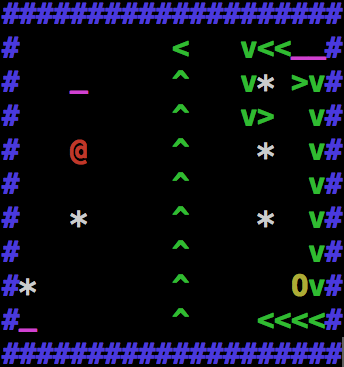 |
 |
 |
| basic.txt | jetsons.txt | open.txt | pacman.txt |
| Easy | Medium | Easy | Medium |
 |
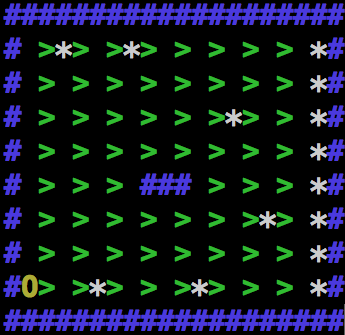 |
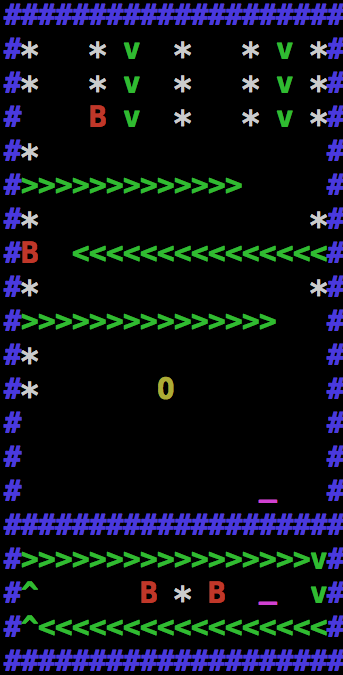 |
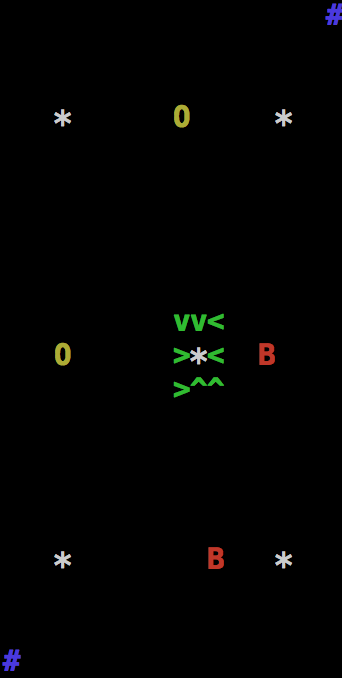 |
| stoleebros.txt | stronglyconnected.txt | tunnels.txt | lastresort.txt |
| Medium | Hard | Hard | Hard |
 |
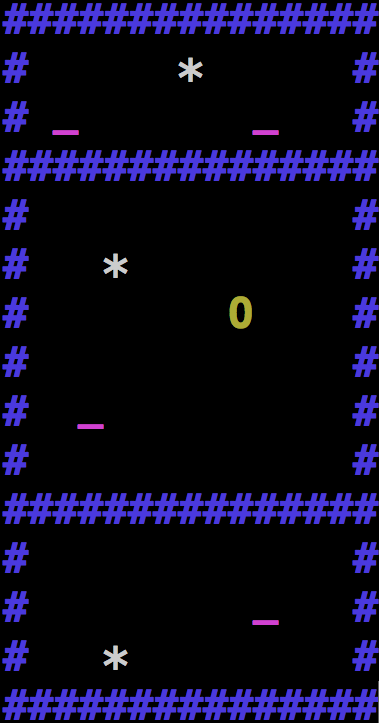 |
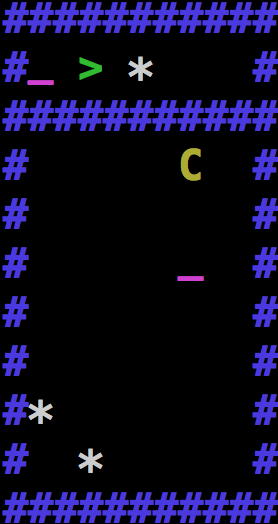 |
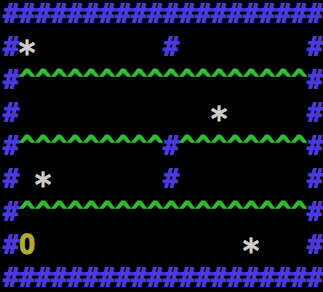 |
| treadmills_test.txt | teleporters.txt | test_for_smart_path.txt | stronglyconnected2.txt |
| Easy | Easy | Hard | Hard |
- 50% for succeeding on Easy instances.
- 40% for succeeding on Medium instances.
- 10% for succeeding on Hard instances.
Part 2A focused on the simplehero, so all test maps had no enemies (or the enemies were disabled using --disable-enemies).
Here is a list of commands that we ran to test your code:
tar xvf *.tar.gz cat README make clean make wget https://orion.math.iastate.edu/dstolee/229/project2/grading2a.tar.gz --no-check-certificate tar xvf grading2a.tar.gz cat test2a.txt >> Makefile make test
The grading tarball includes some updates to the object files to allow for extra grading info. In particular, it will assign partial credit if only some of the eatables are consumed. Type "Enter" to close the final message.
Two of the easy tests use valgrind and --render-off to check for memory leaks or memory errors.
int specifying its type.
This is given as a bitmask using the following identifiers:
ACTOR_HERO-- Iftype & ACTOR_HEROis not 0, then this actor is a hero.ACTOR_ENEMY-- Iftype & ACTOR_ENEMYis not 0, then this actor is an enemy.ACTOR_EATABLE-- Iftype & ACTOR_EATABLEis not 0, then this actor is an eatable.ACTOR_POWERUP-- Iftype & ACTOR_POWERUPis not 0, then this actor is a powerup.ACTOR_DEAD-- Iftype & ACTOR_DEADis not 0, then this actor has been removed from the game. (It also has position (-1,-1).)
ACTOR_POWERUP and the ACTOR_EATABLE powerups.
ncurses to create the game map.
This will cause problems with any writing to standard out if you are rendering the game board.
You can use the --render-off command-line argument to turn off the rendering and then you can use printf as much as you want.
Another option is to use
#include <ncurses.h> and use the line
waddstr(stdscr, "This is a message!\n");This will write the message until the screen is wiped for a new render. If you plan to use this type of message, then you should use command-line arguments (such as
--delay 1000000) to slow the game.